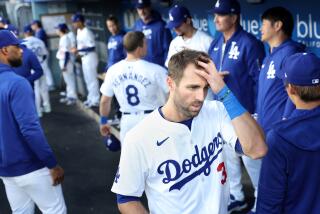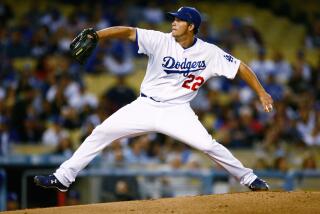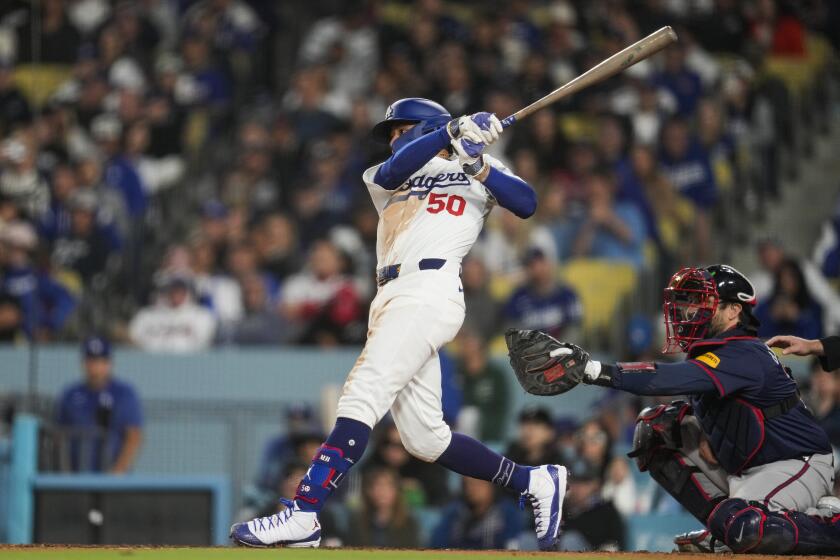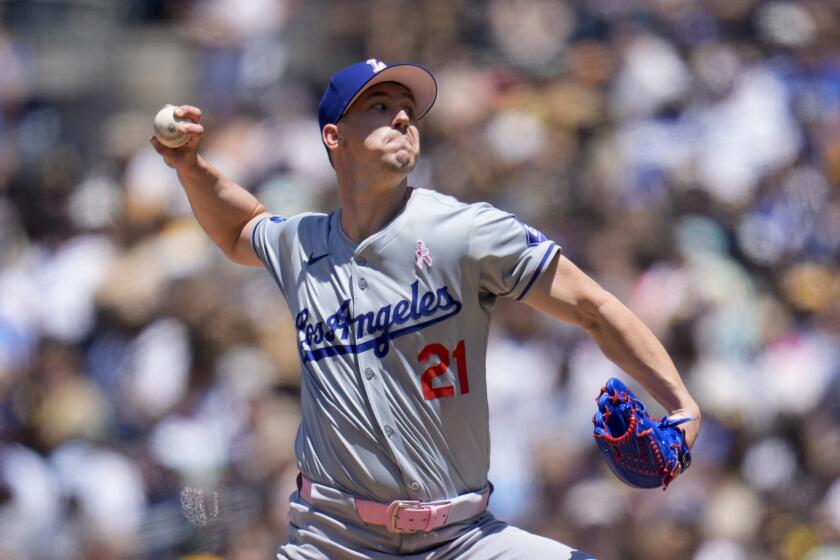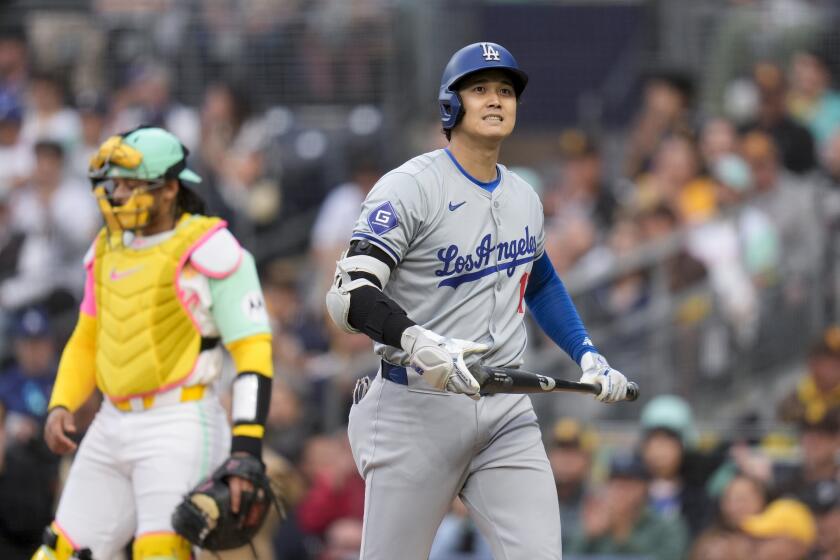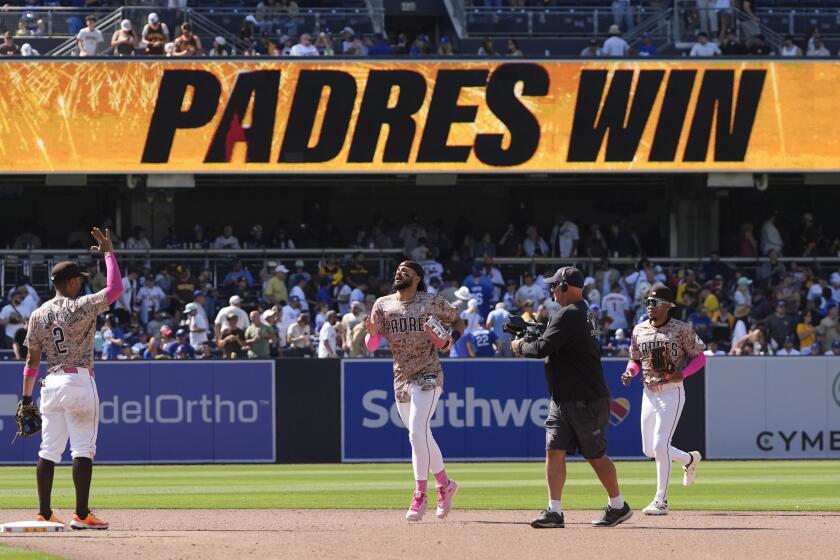THE LONG ROAD BACK : Dodgers Figure the Best Defense Is an Offense to Cover Up for It
In the museum of Tom Lasorda’s mind, memories of the last two Dodger seasons probably would occupy only a small wing tucked behind the vast galleries of those championship seasons. Better yet, a musty storage closet might be more appropriate.
Success must seem like an extinct concept to Lasorda. Last season’s 73-89 finish, an abysmally lifelike replica of the 73-89 record of 1986, included everything that would make a manager rummage around for thoughts of happier times.
“These two years haven’t been fun, that’s for sure,” Lasorda said with more resignation than irony.
But rather than hanker for the past, Lasorda and Executive Vice President Fred Claire embarked on a major restoration project that they believe will remove all unsavory elements of the recent past and return the Dodgers’ to their previous prominence.
It will be a long trip back. Having endured consecutive losing seasons for the first time since 1967-68, the Dodgers will try to avoid being three-time losers for the first time since the mid-1930s, a time that almost exceeds Lasorda’s memory.
Today, when the Dodgers open the season against the San Francisco Giants at Dodger Stadium, only catcher Mike Scioscia and second baseman Steve Sax will start in the same position as last season’s opening day lineup. Thirteen of the roster’s 24 players were not even in the Dodger organization at this time last season.
Prominent new faces include outfielders Kirk Gibson and Mike Davis, shortstop Alfredo Griffin and relief pitchers Jay Howell and Jesse Orosco.
The most important change is a radically redesigned infield, assembled for offense at the expense of defense. Pedro Guerrero will be at third base for the first time since early in the 1985 season, Mike Marshall at first base for the first time since a brief stretch in 1982, and Steve Sax returns to second base despite earlier plans to displace him.
That gives Lasorda a potent lineup featuring five players--Guerrero, Marshall, left fielder Gibson, center fielder John Shelby and right fielder Davis--who averaged 22 home runs and 77 runs batted in last season.
Lasorda, unusually restrained in most preseason pronouncements, has waxed nostalgic about this lineup. He calls his sluggers the “Awesome Fivesome,” and says it is comparable to his championship 1977 club, which featured four players who hit at least 30 home runs.
Obviously, the Dodgers could not solve all their shortcomings in one winter, so they apparently have chosen trying to increase run production over decreasing rampant defensive problems.
Nuggets of negativity were easily unearthed at Chavez Ravine last season. The club finished last in the National League in team batting average, runs scored, on-base percentage and slugging percentage, as well as being first in errors and 10th in saves.
The addition of Gibson and Davis, combined with the production of a healthy Guerrero and Marshall, will help fatten the offensive statistics. Griffin figures to have a stabilizing influence at shortstop, but even the former Gold Glove winner doesn’t have to range to cover for Guerrero’s and Sax’s defensive deficiencies.
Relief pitching, another troubled area, will be improved with Howell and Orosco, but neither had an overpowering spring. The bullpen may need to be vastly improved because starting pitching, once a great Dodger strength, has been weakened with the departure of Bob Welch, lost in the acquisition of Griffin, Orosco and Howell.
But when Claire and Lasorda scan the roster, they see more overall talent and much more potential than the Dodgers had the last two seasons. Whether it will lead to upward mobility in the NL West standings isn’t known, but the powers that be say they are confident.
“I like our ballclub,” Claire said. “I think we have power, speed and a team that has an outstanding attitude. I think that, when you look back at past Dodger teams that have been successful, you’ll see that they had those qualities.
“We’ve got five guys who can hit 20 home runs, five guys who can steal 20 to 25 bases. Pinch-hitting and the bench is much stronger. I like our pitching. I think we have to compare the Dodgers, now, to where the L.A. Dodgers were last season.”
It is a good bet the Dodgers will not finish 73-89 for a third straight season. The law of averages might be one reason, but also the Dodgers do have improved talent. Whether it will be enough to challenge the Giants and Cincinnati in the West is another matter.
Many doubts hinge on what is widely perceived as a porous defense. Though the Dodgers won the division title in 1983 with Guerrero at third base, he still is considered a liability. Marshall has not played first base in more than five years, and Sax, whose throwing problems are history, still is not the best at turning double plays and making routine plays.
In the outfield, Gibson never has been considered a quality defensive player, and Davis had 13 errors as Oakland’s right fielder last season. Shelby is a solid center fielder, but he can cover only so much ground.
Dodger officials recognize the weak defense, but they continue to point to all that offensive potential.
“Baseball is like driving,” Lasorda told reporters early in spring training. “It’s getting home safe that counts. We’re going to score some runs, and we can play defense in the later part of the game.”
Said Claire: “I think we’ll be improved on defense over last year. We have Alfredo, and we have more speed in the outfield. The key part of the infield is Alfredo, who has played very well.”
Gibson, who has compared this Dodger lineup to the offensive powerhouse on which he starred in Detroit in 1984, said that people are making too much of defense.
“What makes it nice when you’ve got people who can (hit the ball) out of the yard is that it makes up for mistakes,” Gibson said. “We’ve got the big bats now, and we can afford to take chances.
“I think you’ll see us score a lot of runs, and I also think we can field better than you guys (reporters) say we can. The main thing is wins and losses. And I think we can win with this lineup.”
Maybe so, but that’s assuming the lineup remains intact. If any principle players suffer an injury, it is likely that the positioning will revert to pre-spring training alignment.
Unfortunately for the Dodgers, they have many players with bulging medical files, which is one reason why Claire was hesitant to trade a major offensive contributor. Guerrero played in 152 games last season, but he has chronic pain in both knees, played most of last season with a sprained left wrist that has bothered him since 1985, and a sore thumb. If Guerrero goes down, Jeff Hamilton will expand on his role as late-inning defensive replacement.
Marshall missed 58 games last season with an assortment of ailments, and if injuries strikes him again, it is likely Guerrero will shift to first base, where he says he feels most comfortable.
Gibson has missed 364 games over 8 seasons with various injuries, and Davis played most of the second half of last season with an injured knee. In the spring, Davis missed time with a sprained ankle and also received an injection Friday for left shoulder soreness. If either outfielder is sidelined, Marshall and/or Franklin Stubbs and Mickey Hatcher will fill in.
Another thing that might break up the Dodger infield is Guerrero’s feelings about playing third base. Early in spring, Lasorda hoped that Guerrero would volunteer to move to third--the only way to get all five power hitters in the lineup. When that didn’t happen, he held a series of delicate meetings with Guerrero, eventually convincing him to make the switch.
Lasorda has been unceasing in his praise of Guerrero, who will become a free agent after the season, for making the switch.
There is concern, however, that Guerrero’s offense will suffer as a third baseman. In Guerrero’s productive 1985 season, he did not become a hot hitter until June, when he switched from third base to left field.
Defensively, Guerrero handles ground balls adequately. But he lacks Hamilton’s range and routinely makes high throws to first base. Although Guerrero’s style of fielding is more Sugar Ray Robinson (ducking and weaving) than Brooks Robinson, he made only two errors in 21 spring games.
“I think the end result is whether he gets the guy out,” Lasorda said. “I don’t care how he looks . . . Do you think it would be better to put Hamilton at third and put one of those guys (power hitters) on the bench? I think you have to get the runs early and then go with defense.”
With an infield featuring Guerrero and Sax, Marshall’s adjustment to playing first base for the first time since brief periods in 1982 will be important. Some have suggested that he use a butterfly net at first base, but Marshall has done all right so far with his glove. He is as skilled at digging out low throws as reaching for high ones with his 6-foot 5-inch frame. Marshall, however, occasionally has problems cleanly fielding ground balls.
Claire has repeated the standard baseball line that, defensively, it is important to be solid up the middle. That is where the Dodgers’ strength lies.
Mike Scioscia is an above average defensive catcher and an extraordinary plate-blocker, and the club kept backup Rick Dempsey ahead of Alex Trevino ostensibly because of his experience in handling pitchers.
Unless Griffin succumbs to the pressure of having to trying to do too much in the field, he should have another solid season at shortstop. Griffin, a Gold Glove award winner in 1985, also is reliable, having played in all 162 games in four of the last six seasons.
And, in center field, Shelby has quietly established himself as a good defensive player while surprising opponents by posting career-high offensive statistics--21 home runs, 69 RBIs--last season.
Shelby won’t need to equal those numbers if other, proven hitters produce. When healthy, Gibson is capable of between 25 and 30 home runs and close to 90 RBIs. Davis had 20 home runs and 53 RBIs at the All-Star break, but his production dropped dramatically after his knee injury.
If the outfielders are productive, the onus will not totally be on Guerrero and Marshall to carry the club.
“Teams can’t come in now and just pitch around Guerrero and not have to worry,” said Orosco, the former New York Met. “It was always that way against the Dodgers. We knew what they lacked. They had fine pitching, but a weak offense. But now, when you add a Gibson, a Mike Davis and a Shelby for a whole year, that really makes it difficult for opposing pitchers.”
Opposing hitters never looked forward to facing the Dodgers’ starting pitching trio of Fernando Valenzuela, Orel Hershiser and Bob Welch. But Welch has switched leagues, and Valenzuela is coming off a 14-14 season in which his ERA was a career-high 3.98. Hershiser had a 16-16 record, including a 2-7 mark when the Dodgers scored two or fewer runs.
Valenzuela, in the final season of his long-term contract, said the tightness in his left shoulder is gone and, with some run support, is hoping to return to his previous form.
The final three spots in the starting rotation will be filled by 43-year-old Don Sutton, a vastly improved Tim Leary and rookie Tim Belcher, who posted a 4-2 record last September after coming to the Dodgers from Oakland as the player to be named in the Rick Honeycutt trade.
All three pitchers had good springs, but all have to prove themselves this season.
For Sutton, it will be the annual scrutiny that comes to all pitchers near or past 40. But if his curveball is still breaking and he can give the Dodgers six solid innings per outing, his signing will have been deemed a success.
For Leary, it will be proving that his 11-1 record in winter ball in Mexico and impressive 1.25 spring ERA is not a fluke. Leary was a major disappointment last season, after coming to the Dodgers from Milwaukee in the Greg Brock trade.
For Belcher, it will be proving that the Dodgers picked the right fifth starter among the spring competitors that included Shawn Hillegas, Alejandro Pena and Ken Howell. Since the Dodgers have two days off in the first two weeks, Belcher probably will not get his first start for a while.
“This staff has questions, but so did the ’79 (Baltimore) Orioles,” said Dempsey, the former Oriole catcher. “We’ve got young guys, and we’re not sure what they’re capable of. But that promise is there. The first month or so is going to be important. They have get confidence.”
Because the starting staff is not as strong as during Welch’s tenure, help from the bullpen is even more necessary than usual.
Howell and Orosco combined for 32 saves for their respective teams last season, which was the Dodgers’ team total. The right- and left-handed short relievers figure to be an improvement over last season’s Matt Young/Ken Howell combination, providing both pitchers remain healthy.
Howell had off-season surgery to remove bone chips from his right elbow and pitched only 9 innings during the Florida portion of spring training because of stiffness in his right forearm, a back strain and a bout with the flu. When Howell did pitch, though, he did not allow an earned run.
Orosco, meanwhile, said reports that he has elbow problems are untrue. He said he has not had an injury to his left elbow since 1983. Regardless of health, Orosco was hit hard this spring, but he said he merely was experimenting with pitches.
Orosco, who complained about lack of work with the Mets last season, figures to get it this season. In fact, Cincinnati Reds Manager Pete Rose joked that Orosco might not be able to salute the flag by June.
“If I feel like I need a day off, I’ll take it,” Orosco said. “I don’t think there’s pressure on me. They’ll get the best I can give them. I’m going to have fun this season. I’m not going to let anything bother me.”
If Orosco and Howell are handed the bulk of the short-relief work, the rest of the bullpen will be used in long relief and as set-up men for the closers. Long relief is important this season, considering that Sutton rarely pitches more than six innings and the uncertainty surrounding other starters.
Pena was in the running for a spot in the starting rotation--the club’s preference for him--before suffering a strained groin two weeks ago. After losing his starting job midway through 1987, Pena worked well out of the bullpen, earning 9 of his 11 saves in September.
But because of major shoulder surgery in 1985, Pena still is unable to pitch on consecutive days. Brad Havens (1 save, 4.33 ERA) is the only other left-handed reliever besides Orosco, so he will be used extensively. The 10th spot on the pitching staff was finally won by Brian Holton after battling Tim Crews, William Brennan and Shawn Hillegas all spring. Holton might end up being counted upon heavily because of other question marks on the staff.
Pitching may or may not be as deep as management had hoped, but the bench clearly is stronger.
Last season, Mickey Hatcher started at third base, first base, right field and left field during the Dodgers’ injury siege. His average was above .300 before a groin injury hampered him the final month.
Hatcher probably will not be forced to bring three gloves to the dugout this season, because Hamilton will be the third-base stand-in and Franklin Stubbs also can fill in at first base and the outfield. Stubbs and Danny Heep will be the left-handed pinch-hitters, and Dave Anderson is a versatile utility infielder.
“I think we’ll be better, all around, because the guys who started a lot last season are now coming off the bench,” Hatcher said. “We’ve got depth and a lot of talent.”
Along with depth and talent, the Dodgers also have diverse personalities. Guerrero and Marshall had two clashes last season, and Marshall fought with teammate Phil Garner, now with the San Francisco Giants. Gibson, as the infamous spring practical joke showed, is not afraid to speak his mind.
How Lasorda, in the final season of his contract, handles this collection of big names and big salaries trying to become a team might be a determination in the Dodgers’ success or failure.
“I don’t think it’s going to be a problem,” Lasorda said. “There’s a good attitude. But they all don’t have to like each other. I remember years when guys didn’t get along, but when they went out on that field, they don’t think about that.
“I think it’s more important that they stay healthy. We’ve had so many guys hurt the last two years. You know how many guys we had on the disabled list. I’ve never seen anything like it.”
Lasorda, no doubt, is hoping he never again will see anything like the last two seasons.
More to Read
Are you a true-blue fan?
Get our Dodgers Dugout newsletter for insights, news and much more.
You may occasionally receive promotional content from the Los Angeles Times.
